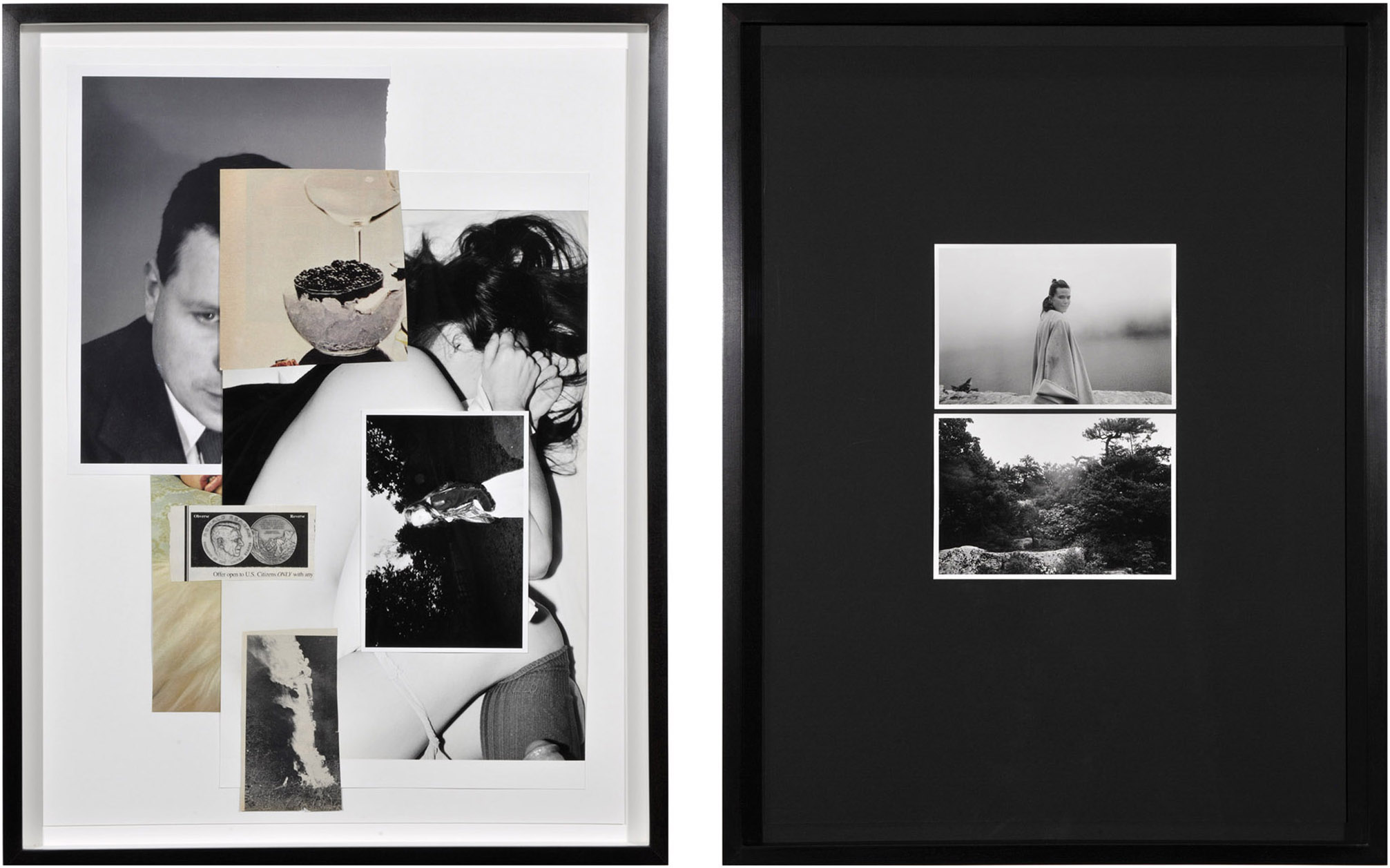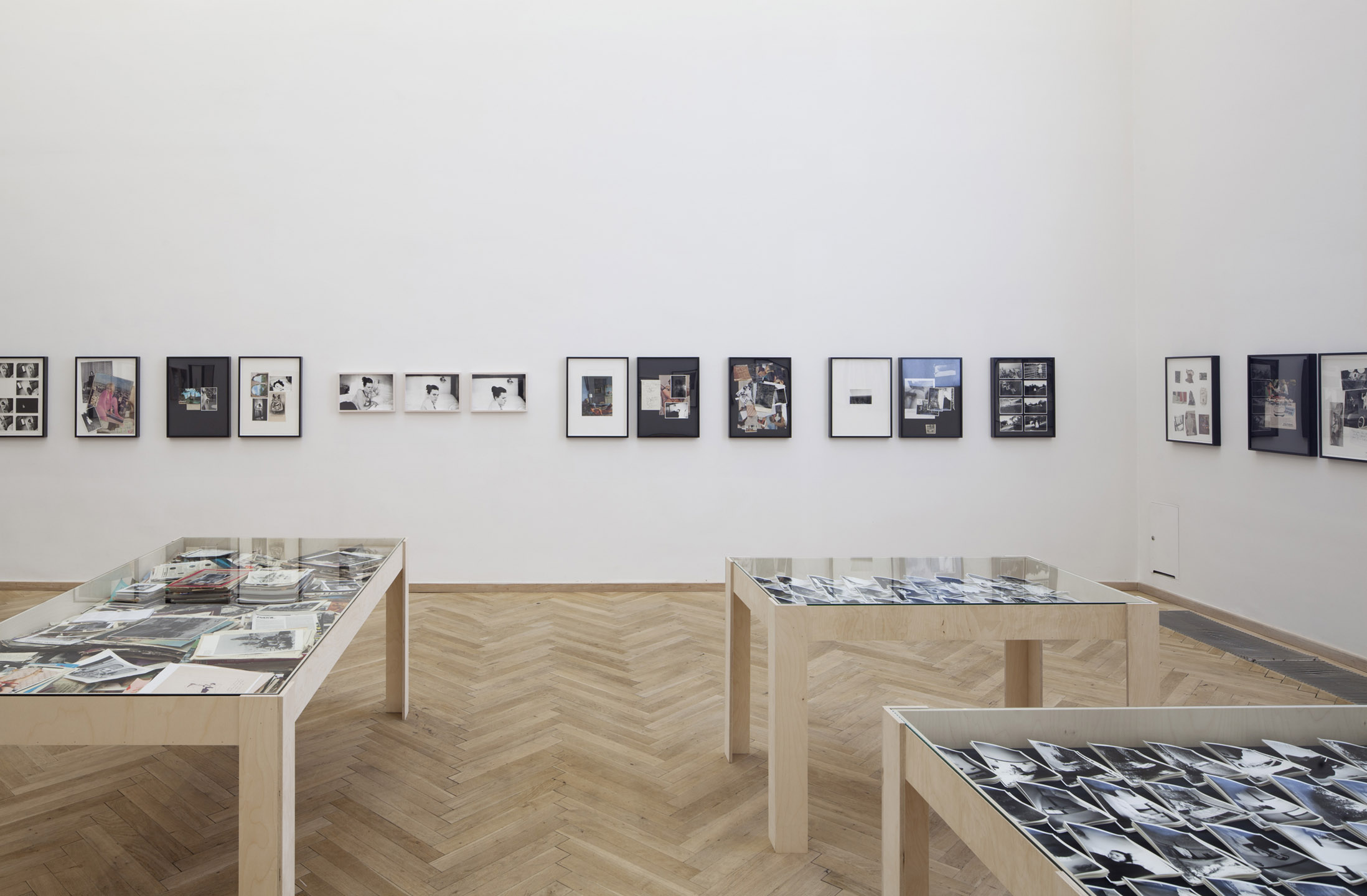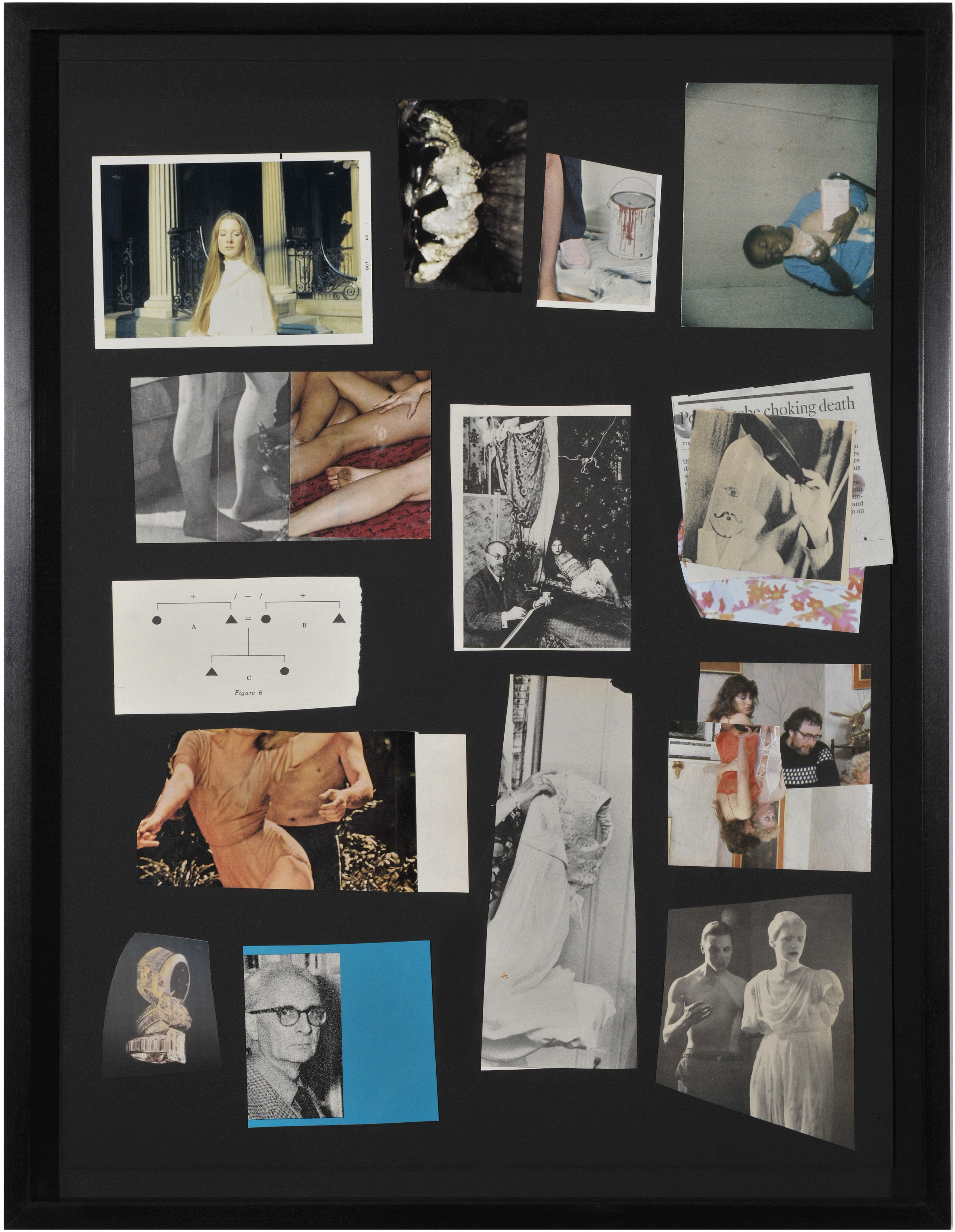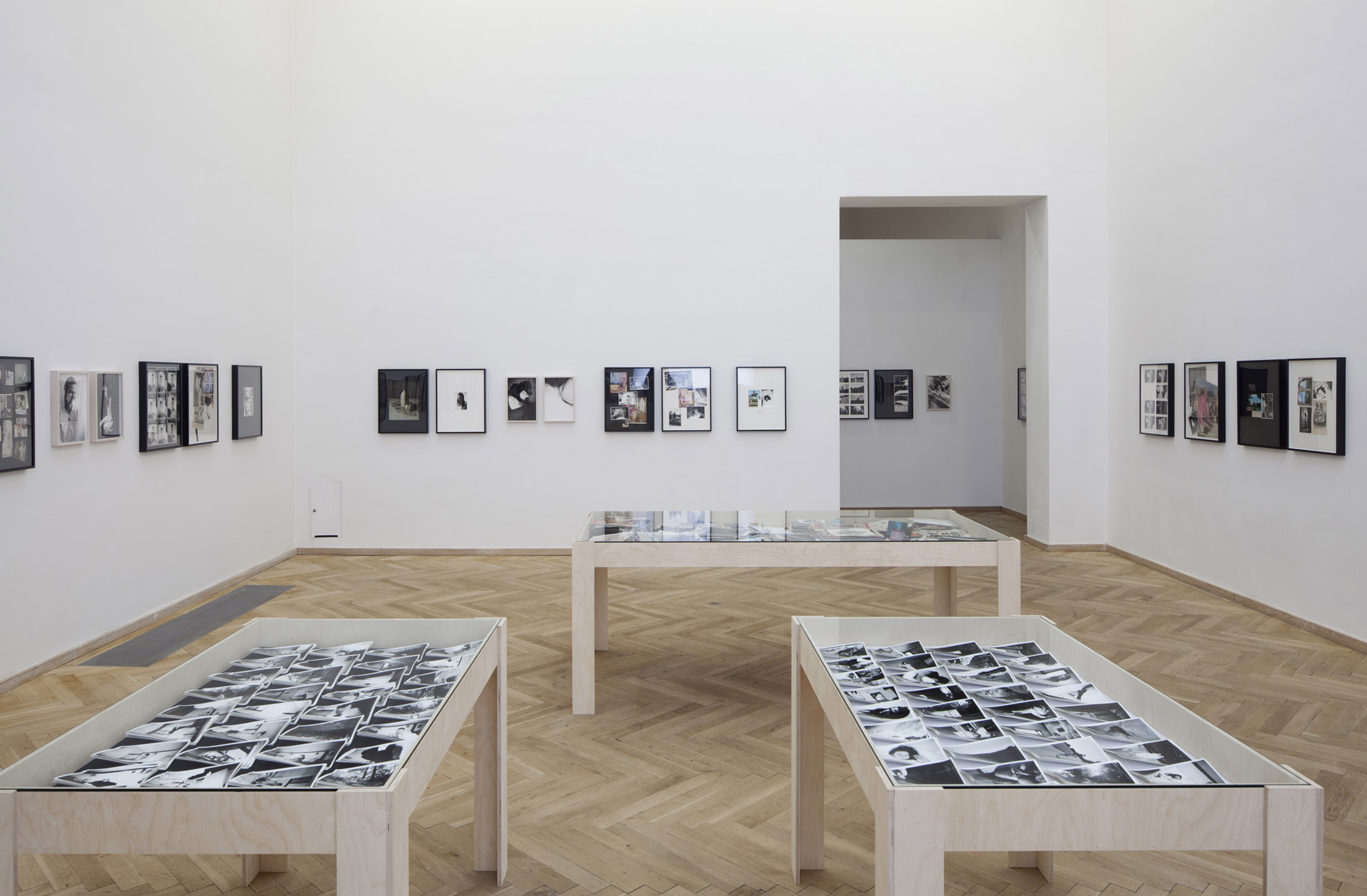Double Bind (2010)
Black & white photographs, various print ephemera, matboard, paper and pencil, vitrines
For the project Double Bind, Ledare intervened into an existing relationship triangle to foreground and examine social processes of habitual enactment—such as what it means “to be a husband or wife.” Through a contractually scripted series of events, the project explored emotional and material terms of exchange, thresholds of public and private fantasy, gender normativity, and symbolic boundaries of relationships—all through the lens of a camera. Ultimately, Double Bind invokes an unravelling of these habituations, using materialist strategies to foreground the contingencies of subjectivity and the cultural codes which underwrite them.
Double Bind began by Ledare appropriating the conceit of marriage as a complex rubric from which to produce two bodies of photographic images. First, the artist convinced his ex-wife to travel with him to a remote cabin in Upstate New York where he photographed her over the duration of four days. Ledare then paid for her to repeat the trip two months later—this time alone with her new husband, a photographer by the name of Adam Fedderly. Following the same photographic parameters, the former and current husbands produced nearly 1000 black and white photographs of Meghan Ledare-Fedderly. These were printed and presented in their entirety by Ledare within Double Bind’s installation. At the molecular level, the photographic icon of Meghan Ledare-Fedderly—framed as “muse”—comprises a doubled signifier. In reading each image, the viewer is forced to hold in mind two distinct relationships—presented on black panels, the photographs of Meghan made by Ledare; and presented on white, those made by her current husband. Products of these distinct relationships, as well as their crossing, each couple’s image can be read as an articulation to the absent third party.
The triangle of ex-husband/(ex)-wife/husband—and the restraints and relays diagrammed through the camera’s act of recording and transmitting information—comprise Double Bind’s first comparative structure. For Double Bind’s installation, Ledare presented these private photographs against a collection of roughly 6000 pieces of ephemera culled from the pages of various cultural, editorial, pornographic, fashion, and advertising print media. Representing a veritable cultural field, these materials serve both as models for the representations and relationships presented within the private images, as well as a lens for their interpretation. Producing 48 montaged works, this second comparative structure was arranged in diptychs, each comprising one black and one white panel. Corresponding to the authorship of either Ledare or Fedderly, this color coding served diagrammatically to manifest and respatialize the triangle between husband, wife and ex-husband.
Contained in three vitrines, the materials left over from Ledare’s construction of the diptychs suggest a representational entropy. This included two small vitrines, separated into black and white backgrounds to hold stacks of Ledare and Fedderly’s images of Meghan; and one large vitrine holding piles of the roughly 6000 tear sheets collected from the mass media.
By linking these systems and mapping the appropriated mass media’s various languages, viewpoints, and positions over those present in the private images, Double Bind proposes a material syntax through which to make graphically intelligible the limitations to agency put in place by both the camera and the mass media’s models. Juxtaposing the mass media’s production of difference, positions, fantasies, and desire against the private photograph’s complex construction of intersubjectivity, Ledare renders the cultural stereotypes and identifications present in the mass media violently evident.
Double Bind ConversationsBy Rhea Anastas and Leigh Ledare
Black & white photographs, various print ephemera, matboard, paper and pencil, vitrines
For the project Double Bind, Ledare intervened into an existing relationship triangle to foreground and examine social processes of habitual enactment—such as what it means “to be a husband or wife.” Through a contractually scripted series of events, the project explored emotional and material terms of exchange, thresholds of public and private fantasy, gender normativity, and symbolic boundaries of relationships—all through the lens of a camera. Ultimately, Double Bind invokes an unravelling of these habituations, using materialist strategies to foreground the contingencies of subjectivity and the cultural codes which underwrite them.
Double Bind began by Ledare appropriating the conceit of marriage as a complex rubric from which to produce two bodies of photographic images. First, the artist convinced his ex-wife to travel with him to a remote cabin in Upstate New York where he photographed her over the duration of four days. Ledare then paid for her to repeat the trip two months later—this time alone with her new husband, a photographer by the name of Adam Fedderly. Following the same photographic parameters, the former and current husbands produced nearly 1000 black and white photographs of Meghan Ledare-Fedderly. These were printed and presented in their entirety by Ledare within Double Bind’s installation. At the molecular level, the photographic icon of Meghan Ledare-Fedderly—framed as “muse”—comprises a doubled signifier. In reading each image, the viewer is forced to hold in mind two distinct relationships—presented on black panels, the photographs of Meghan made by Ledare; and presented on white, those made by her current husband. Products of these distinct relationships, as well as their crossing, each couple’s image can be read as an articulation to the absent third party.
The triangle of ex-husband/(ex)-wife/husband—and the restraints and relays diagrammed through the camera’s act of recording and transmitting information—comprise Double Bind’s first comparative structure. For Double Bind’s installation, Ledare presented these private photographs against a collection of roughly 6000 pieces of ephemera culled from the pages of various cultural, editorial, pornographic, fashion, and advertising print media. Representing a veritable cultural field, these materials serve both as models for the representations and relationships presented within the private images, as well as a lens for their interpretation. Producing 48 montaged works, this second comparative structure was arranged in diptychs, each comprising one black and one white panel. Corresponding to the authorship of either Ledare or Fedderly, this color coding served diagrammatically to manifest and respatialize the triangle between husband, wife and ex-husband.
Contained in three vitrines, the materials left over from Ledare’s construction of the diptychs suggest a representational entropy. This included two small vitrines, separated into black and white backgrounds to hold stacks of Ledare and Fedderly’s images of Meghan; and one large vitrine holding piles of the roughly 6000 tear sheets collected from the mass media.
By linking these systems and mapping the appropriated mass media’s various languages, viewpoints, and positions over those present in the private images, Double Bind proposes a material syntax through which to make graphically intelligible the limitations to agency put in place by both the camera and the mass media’s models. Juxtaposing the mass media’s production of difference, positions, fantasies, and desire against the private photograph’s complex construction of intersubjectivity, Ledare renders the cultural stereotypes and identifications present in the mass media violently evident.
Double Bind Conversations
By Rhea Anastas and Leigh Ledare






